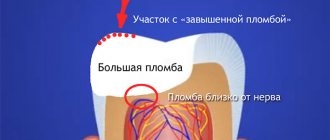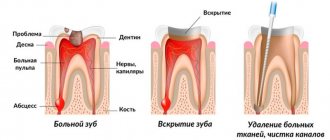From this article you will learn:
- why do teeth hurt, what emergency help is needed,
- what to do if a child has a toothache, how to numb the pain,
- toothache during pregnancy: what to do.
Pain in the teeth is always a sign of inflammation, regardless of whether it occurs in a damaged tooth or after treatment. You can urgently reduce pain in two ways: either by urgently seeking dental help, or
with the help of analgesics.
But you must understand that if you have a toothache, then in any case it will require the intervention of a dentist, and analgesics will only allow you to delay a visit to the doctor.
Emergency help: what to do if your tooth hurts
Thus, if a tooth hurts, the only option is to take tablet analgesics, or try to relieve the pain with dental drops. And this is correct if you need, for example, to get through the night calmly, and the next day you are going to see a doctor.
Of course, there is another option - to suppress the pain with analgesics in the hope that everything will go away. It won't work. And below we will explain why. So what to do if your tooth hurts, and what is the best way to relieve the pain urgently. The answer to this question will differ depending on the cause of the pain, which may be due to -
- or with the development of pulpitis (nerve inflammation),
- or with periodontitis (inflammation at the apex of the tooth root).
What to do to prevent tooth pain due to pulpitis -
When the carious cavity becomes deep enough, and the nerve is separated from it only by a thin layer of healthy tooth tissue, the infection can already penetrate into the tooth cavity and cause inflammation of the nerve. This inflammation of the nerve is commonly called pulpitis.
How to understand that you have pulpitis - acute pulpitis is characterized by severe throbbing pain, which becomes even more severe at night. As a rule, pain is spontaneous, but in some cases it can be provoked by thermal irritants (cold and hot).
With pulpitis, patients often have great difficulty identifying the diseased tooth, because the pain may spread to other teeth. A very important diagnostic criterion for the development of pulpitis is that with pulpitis there is always no pain when biting on a tooth or tapping on it (these symptoms already indicate the development of periodontitis).
Emergency help - what to do if a tooth hurts due to pulpitis: such a tooth can be cured only by removing the inflamed nerve and subsequent filling of the root canals. But, if you need to delay your visit to the dentist a little, then you can relieve the pain at home -
- using strong analgesics (Fig. 1-2),
- using “dental drops” (Fig. 3),
- placing a cotton ball soaked in a solution of 2% Lidocaine (this anesthetic is sold in pharmacies without a prescription) into the carious cavity.
Remember that topical pain relievers (such as dental drops or lidocaine) will only be effective if you have a cavity where you can place a cotton ball soaked in these remedies. If you have a toothache, for example, under a filling, then only tablet analgesics can help you.
Important : what to do if your tooth hurts badly, and analgesics are practically impossible - it is best to urgently go to the dentist, even at night to a 24-hour dental clinic. No one will treat your tooth all night, they will only open your tooth cavity and put arsenic, or remove the nerve and put a special medicine in your tooth (all this will take about 15 minutes). And the rest of the treatment will be carried out at the next visit. But believe me, you will feel almost instant relief.
What to do if a tooth hurts due to periodontitis -
You can be sure that you have periodontitis if any of the following is related to your tooth -
- when biting on a tooth there is pain,
- Previously, a fistula could appear in the projection of this tooth on the gum (Fig. 4),
- swelling of the gums appeared in the projection of the diseased tooth (Fig. 5-6),
- there is swelling of the soft tissues of the face,
- The tooth had already been treated before, but they didn’t just put a filling in it, but they filled the root canals.
With periodontitis, inflammation occurs outside the tooth and consists of the development of a purulent process at the apex of the tooth roots, which over time can lead to both tooth loss and the formation of cysts or granulomas at the apex of the roots.
What to do - only a dentist can cure this tooth disease. If the tooth has not been previously treated, then the nerve must be removed and the root canals filled (24stoma.ru). If the canals were previously sealed poorly (an x-ray will show this), then they need to be unsealed, the inflammation treated and then sealed again. A visit to the dentist is urgent, because... At any moment, with this pathology, the gums may swell or a purulent gumboil may form on half the face.
Emergency help - what to do if a tooth hurts very badly due to periodontitis and you urgently need something to numb the pain - here only tablet analgesics such as ibuprofen, ketoprofen or ketorolac can help you (Fig. 1-2). Any anesthetic drops, rinses, etc. will not be effective, because... the inflammation is localized too deep in the gum.
Acute pain during periodontitis always indicates the formation of a purulent abscess in the area of the apex of the roots of this tooth. If the pain is catastrophic and cannot be tolerated, then it is best to go to a 24-hour dentistry. On your first visit, they will only open the tooth cavity and allow the pus to drain out through the root canals. All this will only take 15 minutes.
For those who are far from the doctor (in the north, in the tundra, in the countryside): we can only sympathize with you. Of course, you can start taking antibiotics and anti-inflammatory drugs, this will at least slow down the development of inflammation and reduce pain, but will not completely solve the problem. Even if we assume that the inflammation suddenly subsides, it can worsen again at any moment.
How to relieve pain?
If you followed all the doctor’s recommendations, but the tooth under the temporary filling hurts again, the following tips may help you:
- avoid contact of food and drinks, especially very hot or cold ones, on the side of the diseased tooth;
- periodically rinse your mouth with soothing infusions of sage, chamomile and mint and a disinfectant solution of salt and soda;
- Inspect the soft tissue surrounding the tooth as often as possible in order to identify the possible onset of an inflammatory process or suppuration. At the slightest hint of swelling or redness of the gums, call your dentist immediately;
- a cotton wool soaked in tincture of valerian and lemon balm and applied to a sore tooth will help temporarily relieve irritation and soothe pain;
- There are also special preparations (drops, gels) designed to relieve toothache, however, before using them, you should consult a specialist.
If your dentist feels there is no cause for concern, try to endure the painful period so as not to interrupt the treatment process. Unfortunately, any inflammatory process is accompanied by unpleasant sensations. It’s better to have pain under a temporary filling than to have to redo a permanent one later.
Toothache during pregnancy: what to do
So, what can you do to relieve pain if your tooth hurts during pregnancy... Remember that even approved medications should be taken by pregnant women only after consulting a doctor.
- Nurofen 200 mg or 400 mg (Fig. 7-8) - it can only be used in the 1-2 trimesters, but not in the 3rd trimester. Nurofen is available in dosages of 200 and 400 mg. Pregnant women can use both dosages. But we recommend that if the pain is not very severe, use a dosage of 200 mg (no more than 4 tablets per day). If the pain is very severe, then the dosage is 400 mg, but not more than 3 tablets per day.
- Paracetamol 500 mg - can be used throughout pregnancy, preferably only after consulting a doctor. No more than 2 tablets per day.
Important: you must understand that analgesics are only a temporary solution to the problem. If you have a toothache, you will still need to see a doctor. There are periods of dental treatment for pregnant women, during which dental treatment is quite safe for both the mother and the unborn child.
Can a tooth hurt after nerve removal?
The dental nerve, or pulp, is a thin bundle of nerves, ligaments and blood vessels that fills the inner cavity of the tooth. It is responsible for blood supply and sensitivity, helps maintain enamel strength and serves as a barrier to infections. Carious processes in the oral cavity can lead to inflammation of the pulp - the so-called pulpitis. To prevent inflammation from spreading beyond the tooth root, the dentist, under local anesthesia, removes the nerve, cleans the canals and fills the tooth. After this operation, he completely loses sensitivity: he stops reacting, for example, to hot and cold.
It would seem that a tooth devoid of nerve endings is not capable of causing its owner any unpleasant sensations, but despite this, patients who have tooth pain after removal of a nerve still turn to dental clinics. So why does this happen?
What to do if a child has a toothache -
If a child has a toothache, how to numb the pain will depend on his age. In children over 6 years of age, it is optimal to use the drug Nurofen 200 mg (contains the NSAID ibuprofen), which is approved from 6 years of age. This drug will not only help relieve severe pain, but also has an anti-inflammatory effect (Fig. 9).
In children aged 3 months and older, it is also optimal to use an NSAID-based analgesic, for example, children's Nurofen in suppositories for the youngest, and in suspension for older children (Fig. 10-11). The package of Nurofen Baby suspension contains a special dispenser that helps measure the required amount of the drug, as well as a diagram that helps to calculate the volume of the drug depending on the child’s body weight.
In addition to Nurofen, from 2-3 months, a child can also use paracetamol-based analgesics, for example, children's Panadol in the form of a suspension (Fig. 12). Each 5 ml of suspension contains 120 mg of paracetamol.
The volume of suspension/dose of paracetamol will depend on the age (body weight of the child). The drug is taken 3-4 times a day, single doses of the drug in “ml” and “mg” depend on the age of the child - are indicated in Table 1. The permitted dose of paracetamol depending on the child’s body weight is -
| Body weight (kg) | Age | Paracetamol dose | |||
| One-time | Maximum daily | ||||
| ml | mg | ml | mg | ||
| 4,5-6 | 2nd month of life | Only on doctor's orders | |||
| 6-8 | 3-6 months | 4.0 | 96 | 16 | 384 |
| 8-10 | 6-12 months | 5.0 | 120 | 20 | 480 |
| 10-13 | 1-2 years | 7.0 | 168 | 28 | 672 |
| 13-15 | 2-3 years | 9.0 | 216 | 36 | 864 |
| 15-21 | 3-6 years | 10.0 | 240 | 40 | 960 |
| 21 -29 | 6-9 years | 14.0 | 336 | 56 | 1344 |
| 29-42 | 9-12 years | 20.0 | 480 | 80 | 1920 |
Features of periodontitis treatment
With periodontitis, the inflammatory process often spreads to the entire ligamentous apparatus of the tooth. The disease is often complicated by an abscess, so its treatment is a difficult task. It is aimed at eliminating pain and eliminating the source of inflammation. As a rule, doctors perform the following manipulations:
- remove accumulated exudate,
- thoroughly clean the root canals,
- treat them with medications,
- filled with filling material.
When choosing treatment tactics, the form of the disease, the degree of pathological changes and the clinical picture are taken into account.










